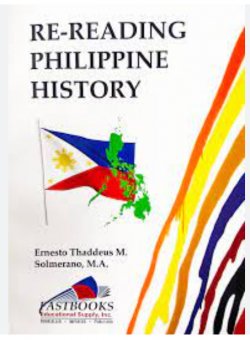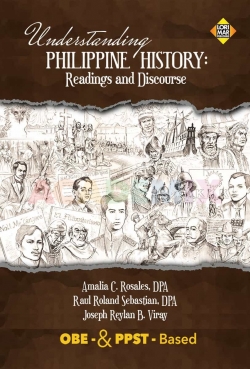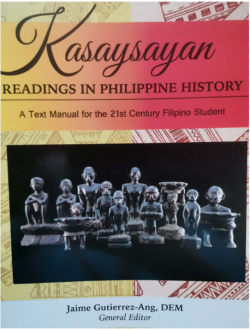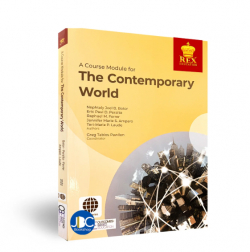A course module for readings in Philippine history
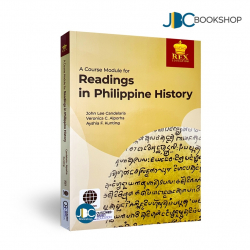
Buy online ($)
Type
Book
Authors
ISBN 13
9786210424133
Category
Filipiniana-Circ.
[ Browse Items ]
Publication Year
2021
Publisher
Rex , Philippines
Pages
xii, 3532 p.: ill.
Subject
1. History--Philippines. 2. Philippine history--Readings.
Tags
Abstract
Reforms to the basic education system of the Philippines have resulted in the introduction of the K to 12 program, a much-needed development since the Philippines has been the last country in Asia with a 10-year pre-university cycle. Globally, the accepted span of basic education is 12 years, and it is recognized as the standard for students and professionals.
With the lengthening of basic education, there is a need for higher education institutions to respond with the same enthusiasm in reforming their respective course offerings and programs. The Commission on Higher Education (CHED) approved the New General Education (GE) Program, which aimed at restructuring the old GE program in higher education institutions to respond to the challenges of the times. The General Education Curriculum (GEC) is geared toward the holistic development of the person in overlapping realms of the individual, the Filipino community, and the global community.
It is in these realities that the General Education course "Readings in Philippine History" is situated, with the course description "Philippine history viewed from the lens of selected primary sources in different periods, analysis, and interpretations." The focus of the course is to develop historical thinking skills connected to context and content analysis, applying both analytical strategies in themes and topics across the Philippine past. Primary sources will be ultimate bridge between the past and the present, allowing spaces for students to simply not repeat facts about the past but to gain knowledge and skills relevant in proposing solutions to the problems of today.
The use of primary sources in studying the past connects the history learner to the text producers themselves, allowing for a richer experience of understanding and appreciation. However, the use of primary sources for those who lack sufficient training and knowledge could also be problematic and may even be a source of misunderstanding and alienation to the historical record. This module is crafted to provide a strategy on how to study Philippine history through primary sources, in hopes that the teacher and the student would have the best opportunity to lean and study about the past while taking great care in watching the steps they take in their attempt to utilize primary sources in history.
Unfortunately, Philippine history, traditionally taken by first-year high school students, was demoted to earlier grade levels. This change makes teaching Readings in Philippine History at the tertiary level a more daunting task: students and teachers alike will have to deal; with at least a six-year gap from the last time the students studied Philippine history. This module is designed with this consideration in mind.
This module is a result of the authors' consultation with history instructors throughout the country through the support of REX Book Store, Inc.'s GEC Workshops. From 2017 to 2019, we met with hundreds of tertiary educators all over the Philippines, from Baguio in the North in the South, who provided us with invaluable insights to improve the content of this module. We also revisited CHED Memorandum Order No. 20, series of 2013, to recontextualize the aims of the course and juxtapose them to the new GEC. We believe that in its current iteration, A Course Module for Readings in Philippine History provides the maximum content that a General Education module could hold.
With the lengthening of basic education, there is a need for higher education institutions to respond with the same enthusiasm in reforming their respective course offerings and programs. The Commission on Higher Education (CHED) approved the New General Education (GE) Program, which aimed at restructuring the old GE program in higher education institutions to respond to the challenges of the times. The General Education Curriculum (GEC) is geared toward the holistic development of the person in overlapping realms of the individual, the Filipino community, and the global community.
It is in these realities that the General Education course "Readings in Philippine History" is situated, with the course description "Philippine history viewed from the lens of selected primary sources in different periods, analysis, and interpretations." The focus of the course is to develop historical thinking skills connected to context and content analysis, applying both analytical strategies in themes and topics across the Philippine past. Primary sources will be ultimate bridge between the past and the present, allowing spaces for students to simply not repeat facts about the past but to gain knowledge and skills relevant in proposing solutions to the problems of today.
The use of primary sources in studying the past connects the history learner to the text producers themselves, allowing for a richer experience of understanding and appreciation. However, the use of primary sources for those who lack sufficient training and knowledge could also be problematic and may even be a source of misunderstanding and alienation to the historical record. This module is crafted to provide a strategy on how to study Philippine history through primary sources, in hopes that the teacher and the student would have the best opportunity to lean and study about the past while taking great care in watching the steps they take in their attempt to utilize primary sources in history.
Unfortunately, Philippine history, traditionally taken by first-year high school students, was demoted to earlier grade levels. This change makes teaching Readings in Philippine History at the tertiary level a more daunting task: students and teachers alike will have to deal; with at least a six-year gap from the last time the students studied Philippine history. This module is designed with this consideration in mind.
This module is a result of the authors' consultation with history instructors throughout the country through the support of REX Book Store, Inc.'s GEC Workshops. From 2017 to 2019, we met with hundreds of tertiary educators all over the Philippines, from Baguio in the North in the South, who provided us with invaluable insights to improve the content of this module. We also revisited CHED Memorandum Order No. 20, series of 2013, to recontextualize the aims of the course and juxtapose them to the new GEC. We believe that in its current iteration, A Course Module for Readings in Philippine History provides the maximum content that a General Education module could hold.
Description
Contents
Unit I: Introduction to history
Unit II: Analyzing primary sources in Philippine history
Unit III: Problems in interpreting Philippine history
Unit IV: Issues in Philippine history
Unit V: Doing history
Unit I: Introduction to history
Unit II: Analyzing primary sources in Philippine history
Unit III: Problems in interpreting Philippine history
Unit IV: Issues in Philippine history
Unit V: Doing history
Biblio Notes
Notes:
Includes bibliographical references and index.
Includes bibliographical references and index.
Number of Copies
2
| Library | Accession No | Call No | Copy No | Edition | Location | Availability |
|---|---|---|---|---|---|---|
| Main | 797 | Fil-C. DS668 C36 2021 | 1 | 2021 Edition | Filipiniana Section | Yes |
| Main | 798 | Fil-C. DS668 C36 2021 | 2 | 2021 Edition | Filipiniana Section | Yes |
